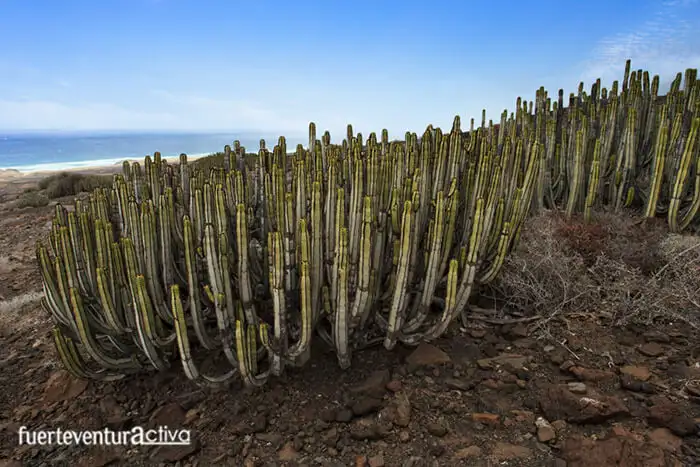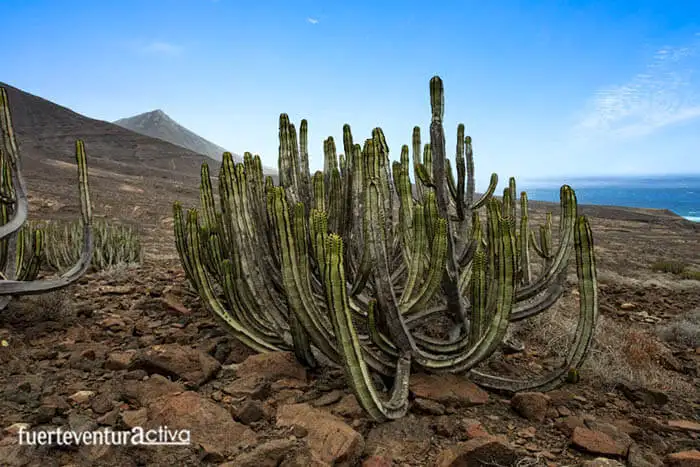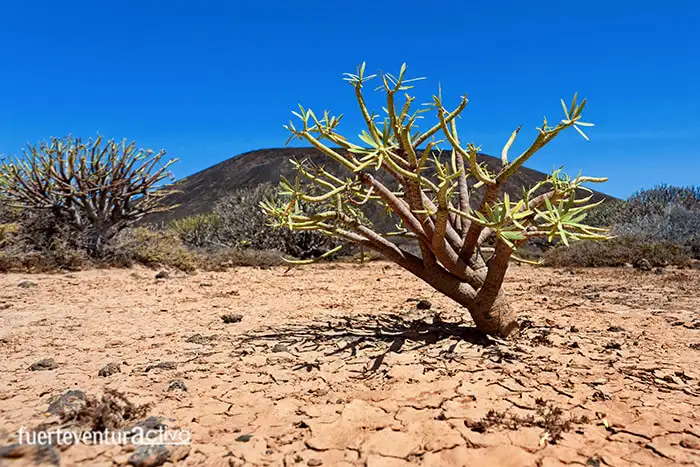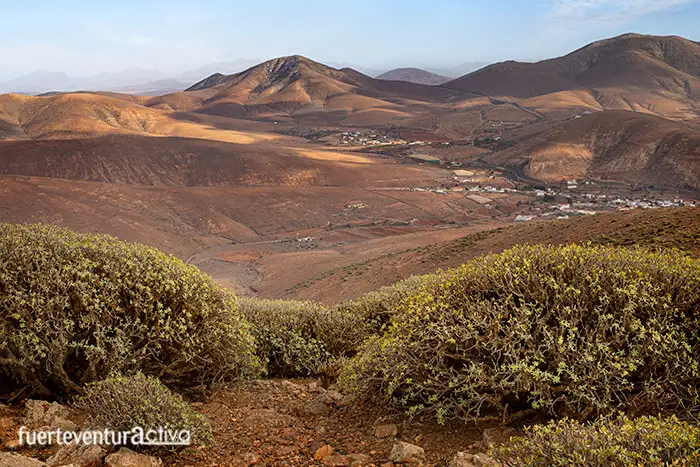What to see in Fuerteventura ?
Tabaibas and cardones
The Tabaibas and the cardones, together with the gorse, are the most representative plants of the Fuerteventura landscape. Both (tabaibas and cardones) belong to the genus of the Euphorbiaceae, and have been used in a similar way, for generations.
In Le Canarien, the chronicles of the conquest of Fuerteventura (XV century), a description is made of the extensive cardonales and tabaibales that covered the island, at the time of the Franco-Norman conquest:
The country is full of other trees that distil a medicinal milk, like balsam (tabaiba), and other trees of wonderful beauty (cardón), that distil more milk than any other tree, and are squares with several faces and on each edge there is a row of thorns like a bush, and its branches are as thick as a man’s arm, and when it is cut, it is filled with milk of wonderful virtue.
The cardón in Fuerteventura.

The cardón (Euphorbia canariensis) is an endemic shrub of the Canary archipelago. It has the appearance of a cactus. It is one of only two cactus species in the Euphorbia family. The other species that looks like a cactus is the cardón of Jandía.
The Canary cardon is a perennial plant that can reach 4 meters in height. The most characteristic are its four- or five-sided stems, greenish in color that turn silver-gray with age.
His arms are grouped into huge chandeliers. Greenish lines can be seen on the stems. These lines mark the annual growth of the plant and can indicate the approximate age. Cardones have been found over 100 years old. Depending on the length between the annual lines, it is possible to know the climatic conditions of each year
Uses of the cardón before the conquest.

Wicks: The wicks used to start the fire were manufactured with the tabaiba and the dried cardones.
Historical documents describe that:
“They drew (…) fire with a dry hawthorn stick, burning it on a dry cardón, which is spongy; and with the strong movement, fire was lit in the cardón, and in this way they had fire “
Catching fish: Tabaibas and cardones were essential to fish using the embrocketing technique
The technique consists of taking advantage of natural pools during low tide, with stone walls, the fish being trapped after high tide. Then the sap of the cardón or bitter tabaiba was dissolved in the water, whose poisonous qualities put the fish to sleep, thus enabling their capture.
The cardón juice was dried and a powder was obtained with which bones, open or infected wounds were treated and cauterized. It was also a good purgative.
The tabaibas in Fuerteventura.

In the Canary Islands a wide group of plants of the Euphorbia family are called “tabaiba”, with two species standing out on the island of Fuerteventura: sweet tabaiba (Euphorbia balsamífera) and bitter tabaiba (Euphorbia regis-jubae).
The sweet tabaiba is a shrub that rarely exceeds two meters in height. It has grayish stems, highly branched from the base, which gives it a squat appearance.
Bitter tabaibas are characterized by the fact that their branches are separated from the ground from a main trunk, giving the plant a more slender appearance.
In summer the tabaibas lose their leaves due to the high insolation and low rainfall.

Uses of tabaiba in pre-Hispanic times.
The first settlers of Fuerteventura had to adapt to the environment, learning to use what nature offered them. Soon they began to use tabaibas for different purposes.
Mending fractures: The fractured limb was laid to rest on a tabaiba splint and secured with reed ropes and leather straps.
Strengthening the teeth: As the sweet tabaiba resin coagulates quickly in the sun, and loses its flavor and the harsh and spicy smell that it has when it is liquid, it has been used, since pre-Hispanic times, as chewing gum or gum, strengthening and cleaning the teeth.
Cauterize wounds: The latex of the bitter tabaiba served to heal the abrasions of the thorns and cauterize warts or skin tumors. Also when wood chips were introduced into the skin.

Uses of tabaibas after colonization.
With the arrival of the European colonizers, new uses appeared to give to the tabaiba.
The latex was used to close the letters as sealing wax, mixing it with the dragon tree sap. Also as glue to catch birds, close the udders of goats when they were loaded with milk and thus be able to wean the baifos. Both George Glas and Viera and Clavijo point out that the juice of this plant was used as pitch to caulk ships.
As a pain reliever to relieve colds, treat chronic arthritis and old dislocations. For this, a poultice was applied on the chest or the healing area, dissolving the latex of the tabaiba in oil.
These remedies and uses have been practiced until recently, some Majoreros still remember chewing tabaiba gum in their childhood.
Fuerteventura3 Fuerteventura8





